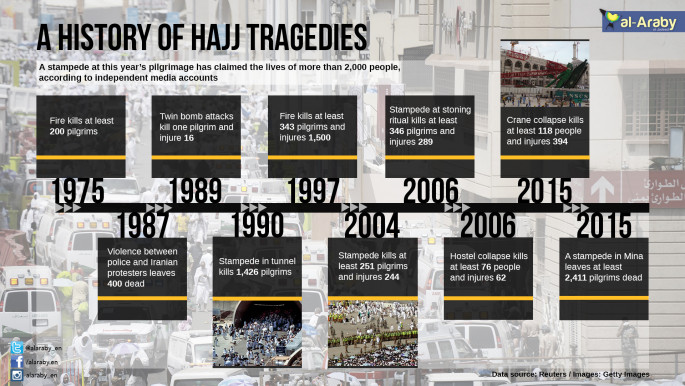Hundreds killed in deadliest hajj crush in 25 years
At least 863 pilgrims were injured in the crush, said the Saudi civil defence directorate, which provided the death toll. The tragedy struck as Muslims around the world marked the start of the Eid al-Adha holiday.
It was the second major disaster during this year's hajj season, raising questions about the adequacy of measures put in place by Saudi authorities to ensure the safety of the roughly two million Muslims taking part. A crane collapse in Mecca nearly two weeks ago left 111 people dead.
Saudi Arabia takes great pride in its role as the caretaker of Islam's holiest sites and host to millions of pilgrims annually.
| Thursday's tragedy struck during a morning surge of pilgrims at the intersection of streets 204 and 223 |
But the hajj poses an immense logistical and security challenge for the kingdom given the sheer number of hundreds of thousands of people, from differing linguistic and cultural backgrounds, many of whom have saved for years for a once-in-a-lifetime opportunity, intent on following the same set of rituals at about the same time.
Thursday's crush happened in Mina, a large valley about five kilometres (three miles) from Mecca that has been the site of hajj stampedes in years past.
Mina is where pilgrims carry out a symbolic stoning of the devil by throwing pebbles against three stone columns. It also houses more than 160,000 tents where pilgrims spend the night during the pilgrimage.
Thursday's tragedy struck during a morning surge of pilgrims at the intersection of streets 204 and 223 as the faithful were making their way toward a large structure overlooking the columns, according to the Saudi civil defense directorate.
The multi-story structure, known as Jamarat Bridge, is designed to ease the pressure of the crowds and prevent pilgrims from being trampled.
Ambulance sirens blared as rescue crews rushed the injured to nearby hospitals.
More than 220 rescue vehicles and some 4,000 members of the emergency services were deployed soon after the stampede to try to ease the congestion and provide alternative exit routes, according to the directorate.
Amateur video shared on social media showed an horrific scene, with scores of bodies - the men dressed in the simple terry cloth garments worn during hajj - lying amid crushed wheelchairs and water bottles along a sunbaked street.
Survivors assessed the scene from the top of roadside stalls near white tents as rescue workers in orange and yellow vests combed the area.
International media covering the hajj were restricted from visiting the site of the accident for several hours and from immediately leaving an Information Ministry complex where the press is housed during the final three days of the pilgrimage per government rules.
Some 2 million people are taking part in this year's hajj pilgrimage, which is an obligation of every able-bodied Muslim. The pilgrimage began in earnest Tuesday.
Saudi authorities take extensive precautions to ensure the security of the hajj and the safety of pilgrims. There are about 100,000 security forces deployed this year to oversee crowd management and ensure pilgrims' safety during the five-day pilgrimage.
| | |
| Ambulances attend the chaotic scene |
At Mina specifically, authorities have put measures in place over the years to try to alleviate the pressure posed by masses of pilgrims converging on the site of the stoning ritual.
Officials use surveillance cameras and other equipment to limit the number of people converging on the site, and the Jamarat Bridge has multiple exits to facilitate the flow of people.
But tragedies are not uncommon.
The death toll from Thursday's crush far exceeded that of a similar incident in 2006, near the same site, when more than 360 pilgrims were killed in a stampede. Another stampede at Mina in 2004 left 244 pilgrims dead and hundreds injured.
The deadliest hajj-related tragedy happened in 1990, when at least 1,426 pilgrims perished in a stampede in an overcrowded pedestrian tunnel leading to holy sites in Mecca.
The latest tragedy is certain to have touched many different countries as the victims likely included pilgrims of different nationalities.
At least 41 Iranian pilgrims perished and at least 60 were injured in Thursday's crush, according to the chief of the Iranian hajj organizing agency.
Saeed Ohadi blamed Saudi Arabia for "safety errors" and said in comments to Iranian state TV that "mismanagement by the Saudis" led to the tragedy.
Thursday's crush happened less than two weeks after a giant construction crane came crashing down on the Grand Mosque in Mecca, the focal point of the hajj.
Authorities blamed the crane collapse on high winds during an unusually powerful storm, and faulted the construction giant Saudi Binladin Group, which oversees construction at the mosque, for not following operating procedures.
least 111 people and injured more than 390.
Previous hajj tragedies
2006: 364 pilgrims die in a crush at the eastern entrance of the Jamarat Bridge during the stone-throwing ritual
2004: 251 Muslim pilgrims die in a crush in Saudi Arabia near the Jamarat Bridge during the stoning of the devil.
1998: 119 Muslim pilgrims are crushed to death at the hajj.
1997: 343 pilgrims killed and 1,500 injured in a tent fire at the hajj camp at Mina.
1994: 270 killed in a stampede near Jamarat Bridge in the area where pilgrims ritually stone the devil.
1990: 1,426 pilgrims were killed in a stampede inside al-Muaissem tunnel.
1987: 400 people die as Saudi authorities confront pro-Iranian demonstration.
1975: More than 200 are killed in a fire after a cooking gas cylinder exploded in the pilgrim tent city.
 |



